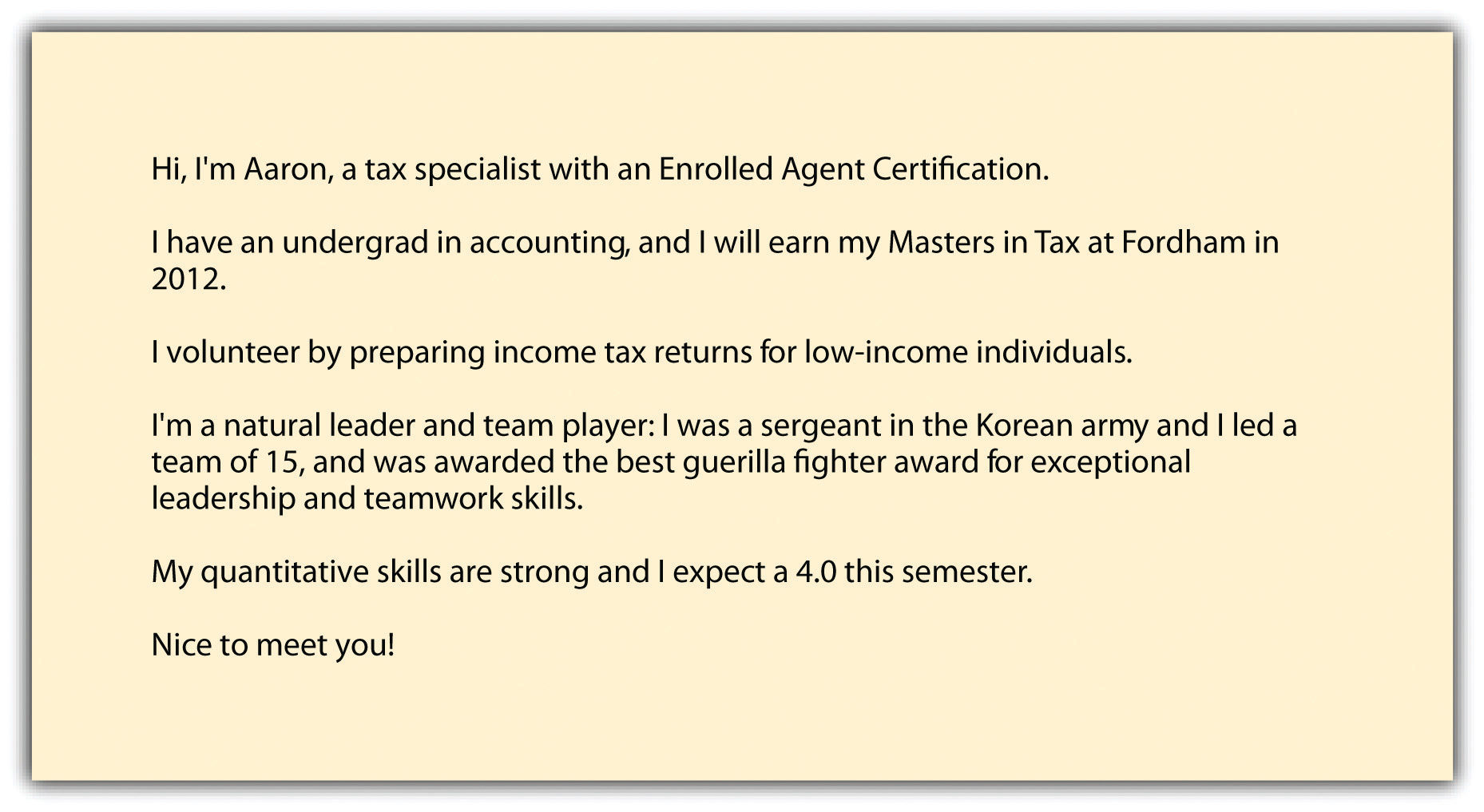This is “Your Networking Pitch”, section 5.3 from the book Job Searching in Six Steps (v. 1.0). For details on it (including licensing), click here.
For more information on the source of this book, or why it is available for free, please see the project's home page. You can browse or download additional books there. To download a .zip file containing this book to use offline, simply click here.
5.3 Your Networking Pitch
Learning Objectives
- Learn the key components of an effective pitch.
- Follow a template to craft your individual pitch.

A networking pitch was originally termed an elevator pitch because in the time an elevator takes to go between floors (generally thirty to forty seconds), you should be able to articulate your value proposition (the skills you have and the position you are seeking). The elevator pitch is now also called the professional pitch, the networking pitch, or simply the pitch.
This thirty- to forty-second summary should be spoken, or delivered, in a confident and convincing manner, making a strong impression. If your pitch is too long and drawn out, it lacks conviction. When meeting networking contacts, recruiters, and hiring managers, this is your one chance to make a great impression and present yourself with clarity. No one wants to listen to a long, drawn-out speech. Make your pitch clear and concise, enabling the person who is listening to know exactly what type of job search candidate you are.
How do you craft an effective pitch? Three steps will ensure your success:
- Write your pitch.
- Edit your pitch until it sounds just right.
- Practice delivering your pitch verbally, and further edit it as needed because we do not write the same way that we speak. Continue rehearsing and repeating your pitch to ensure that your delivery is natural, convincing, and authentic.
Any information you can share that distinguishes you from others is very helpful. Perhaps you have something unique in your background:
- You speak two or three languages.
- You lived abroad for a particular length of time.
- You achieved something significant athletically or musically.
- You volunteered in a meaningful way and perhaps raised extraordinary funds for various charities.
Distinguish yourself from others in whatever way you can to ensure you are remembered in a positive light.
You will deliver your pitch at different times and occasions, including the following:
- Career fairs present an opportunity to meet representatives from various firms. These individuals will meet many students or candidates, so it is important that you make sure your pitch is short and crisp. Also be certain to do your research on their company, as many candidates do not.
- Networking events enable you to first meet someone in a more relaxed setting.
- Interviews often begin with the interviewer asking for a summary of your background or asking that you take one or two minutes to let them know about you. Include high-level themes in your past (e.g., you’ve always been involved in health care at some point in your schooling and in your career). If themes are not apparent, talk about your achievements and the quality of your efforts.
Step 1: Write Your Pitch
Your pitch should answer the following five questions:
- What is your educational background? Detail every college or university you attended, your major and minor, and your expected degree and graduation month and year (include your GPA if it is 3.3 or higher).
- Do you have any pertinent experience in the field in which you are interested?
- What are your critical skills and strengths? Highlight your top two or three skills.
- What do you want to do? Be specific regarding industry, function, and geography (see Chapter 3 "Step 1: Identify Your Job Search Targets").
- Why would you be good at the position? Focus on presenting your top two or three skills, and the skills you have that are necessary to succeed at the job you are targeting.
Type the answers to the preceding five questions, filling one complete page (8½ × 11).
Step 2: Edit Your Pitch
Once your pitch is written, review and edit it accordingly. You should use words that come naturally to you because the more natural the delivery, the more impressive the pitch. Here are some steps you can consider while editing your pitch:
- After you edit the one-page answers to the pitch questions, ensuring that you’ve covered all the important items, cut it to half a page; this forces you to prioritize the essential elements.
- After you edit the half-page document, ensuring that you’ve covered all the important items, cut it in half again (it’s now one-quarter of the page); this forces you to be even more ruthless in prioritizing.
- After you edit the quarter-page document, ensuring you’ve covered all the important items, cut it in half again, leaving only four or five key bullets; this forces you to be concise and select just the most important items.
Step 3: Practice Delivering Your Pitch
Once you have the final pitch in writing, you’ll need to practice, then practice, then practice some more. Your pitch should be spoken in a confident and compelling manner.
- Deliver your speech out loud to ensure it flows smoothly and addresses your career highlights. Practice it until you have it memorized. Practice until you can repeat it when someone shakes you from your sleep at 3:30 in the morning and you maintain your passion when saying it.
Figure 5.4 "Sample Pitch 1" through Figure 5.7 "Sample Pitch 4" are four sample pitches.
Figure 5.4 Sample Pitch 1

Figure 5.5 Sample Pitch 2

Figure 5.6 Sample Pitch 3

Figure 5.7 Sample Pitch 4

Key Takeaways
- A networking pitch articulates your value proposition (i.e., the skills you have that match the position you are seeking).
- Your pitch should contain your education background, experience related to the field in which you are interested, your critical skills and expertise, what you want to do, and why you would be good at it.
- Writing your pitch and editing it will enable you to get the right content and tone.
- Practicing the delivery of your pitch will ensure your delivery is natural and confident.
Exercises
- Type your pitch on a one-page document, and trim it until it’s just four or five bullets in length.
- Pair up with a pitch buddy to practice with each other and critique and strengthen your pitch. Does your buddy understand your value and what you want to do? Does your buddy’s pitch give you any ideas on how to improve yours?
- Practice your pitch until you can say it naturally, without any hesitation.




